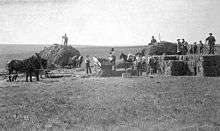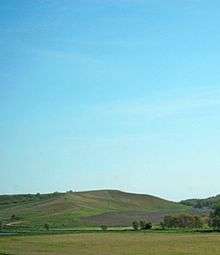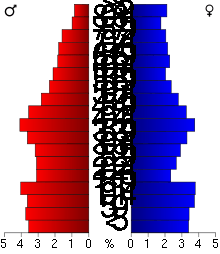Nobles County, Minnesota
| Nobles County, Minnesota | |
|---|---|
|
Nobles County Courthouse in Worthington | |
 Location in the U.S. state of Minnesota | |
 Minnesota's location in the U.S. | |
| Founded |
May 23, 1857 (created) 1870 (organized)[1] |
| Named for | William H. Nobles, a member of the Territorial Legislature |
| Seat | Worthington |
| Largest city | Worthington |
| Area | |
| • Total | 723 sq mi (1,873 km2) |
| • Land | 715 sq mi (1,852 km2) |
| • Water | 7.5 sq mi (19 km2), 1.0% |
| Population (est.) | |
| • (2015) | 21,770 |
| • Density | 30/sq mi (12/km²) |
| Congressional district | 1st |
| Time zone | Central: UTC-6/-5 |
| Website |
www |
Nobles County is a county located in the U.S. state of Minnesota. As of the 2010 census, the population was 21,378.[2] Its county seat is Worthington.[3] The county was formed in 1857 and organized in 1870.
Nobles County comprises the Worthington, MN Micropolitan Statistical Area.
History



Nobles County was first occupied by the Sisseton Sioux. The first white man to set foot on the land was Joseph Nicollet who came to map out the area in 1842. Nicollet named Lake Okabena (there were two Lake Okabenas at the time), Lake Ocheda, East and West Graham Lake and the Kanaranzi Creek.
The first settlement was near Graham Lakes in 1846. Nobles County was established May 23, 1857, and organized October 27, 1870. The county was named for William H. Nobles, who was a member of the Minnesota territorial legislature in 1854 and 1856. In the autumn of the latter year he began the construction of a wagon road for the U.S. government, crossing southwestern Minnesota and Nobles County, to extend from Fort Ridgely to the South Pass in the Rocky Mountains. This work was continued in 1857 but was not completed.[4] Nobles County was created by the Minnesota Legislature on May 23, 1857, just before the full force of the Panic of 1857 was felt. Settlers were further discouraged from coming by the Spirit Lake Massacre of 1857. In this incident, a band of Sioux ruthlessly murdered settlers in Spirit Lake and along the Des Moines River in Jackson and Cottonwood Counties. The few whites in the area were understandably reluctant to stay.
During the summer of 1867, a mail route was established from Blue Earth through the Graham Lakes settlement to Yankton, South Dakota. In January, a Post Office was established in each settlement. The population in the spring of 1870 was 117 and nearly doubled by fall. County Government did not start until 1870. The first railroad, the St. Paul & Sioux City Railway, was built in 1871. This later became the Chicago Northwestern Railroad, and is now operated by the Union Pacific Railroad.
In 1871, a group of men from Toledo, Ohio organized a company to locate a colony of settlers in some western county. After traveling 20,000 miles in the Midwest, they decided on Nobles County and by the spring of 1872, hundreds of people came in and took up land. Worthington became the County Seat in 1873. The Worthington & Sioux Falls Railway was established in 1876. This led to rapid settlement in Rushmore, Adrian, and the western portions of the county.
The U.S. census of 1861: 11 families, 35 persons, (3 from Norway, 3 from Bavaria, 1 from Ireland and the rest from the eastern states). In 1880, the population was 4,435. In 1895, the population was 11,905 and in 1970, the population was up to 22,959. In 2000, the population was 20,832.[5]
- Learn more about Nobles County History by reading Rose's History of Nobles County online
- Visit the Nobles County Historical Society website NCHS Website
Geography

According to the U.S. Census Bureau, the county has a total area of 723 square miles (1,870 km2), of which 715 square miles (1,850 km2) is land and 7.5 square miles (19 km2) (1.0%) is water.[7]

Lakes
- East Graham Lake: Graham Lakes Township
- Fulda First Lake: Seward Township
- Indian Lake: Indian Lake Township
- Iowa Lake: western half in Indian Lake Township; eastern half in Round Lake Township in Jackson County
- Jack Lake: Graham Lakes Township
- Kinbrae Lake: Graham Lakes Township
- Lake Bella: Bigelow Township
- Lake Ocheda: Bigelow Township and Indian Lake Township
- Lake Okabena: Worthington Township
- West Graham Lake: Graham Lakes Township
- Willow Lake: southern third in Bloom Township; northern two thirds in Iona Township of Murray County
Major highways
 Interstate 90
Interstate 90 U.S. Highway 59
U.S. Highway 59 Minnesota State Highway 60
Minnesota State Highway 60 Minnesota State Highway 91
Minnesota State Highway 91 Minnesota State Highway 264
Minnesota State Highway 264
Adjacent counties
- Murray County (north)
- Cottonwood County (northeast)
- Jackson County (east)
- Osceola County, Iowa (southeast)
- Lyon County, Iowa (southwest)
- Rock County (west)
Geology
Nobles County sits atop a geologic structure known as the Buffalo Ridge, a large expanse of rolling hills in southwestern Minnesota reaching a height of 1,995 feet (608 m) above sea level. The Buffalo Ridge extends 60 miles through Lincoln, Lyon, Pipestone, Murray, Rock, and Nobles counties. It is a drainage divide separating the watersheds of the Mississippi and Missouri Rivers. Because of its high altitude and high average wind speed, the Buffalo Ridge has become a major site for wind energy. Over 200 wind turbines stand along the Buffalo Ridge.
The Buffalo Ridge is part of the inner coteau and is the highest point of the Coteau des Prairies in Minnesota.[9] Its bedrock is formed of Cretaceous shale, sandstone and clay that lie above the pinkish-red Upper Precambrian Sioux Quartzite.[10] These units are covered in most areas by thick deposits of glacial drift, which consist of up to 800 feet (244 m) of pre-Wisconsin age glacial till left after the glaciers receded. The inner coteau is made up of extremely stream-eroded glacial deposits of pre-Wisconsin glacial drift, which is then covered by a 6 to 15 foot (1.8 to 4.6 m) thick deposit of a wind-blown silt called loess.[9] This covering results in the creation of an area with long, gently sloping hills. Loess is an easily eroded material, and because of this there are few lakes and wetlands in the inner coteau area. Loess however promotes well established dendritic drainage networks, the majority of which flow into the Missouri River and Minnesota River systems.
Demographics
| Historical population | |||
|---|---|---|---|
| Census | Pop. | %± | |
| 1860 | 35 | — | |
| 1870 | 117 | 234.3% | |
| 1880 | 4,435 | 3,690.6% | |
| 1890 | 7,958 | 79.4% | |
| 1900 | 14,932 | 87.6% | |
| 1910 | 15,210 | 1.9% | |
| 1920 | 17,917 | 17.8% | |
| 1930 | 18,618 | 3.9% | |
| 1940 | 21,215 | 13.9% | |
| 1950 | 22,435 | 5.8% | |
| 1960 | 23,365 | 4.1% | |
| 1970 | 23,208 | −0.7% | |
| 1980 | 21,840 | −5.9% | |
| 1990 | 20,098 | −8.0% | |
| 2000 | 20,832 | 3.7% | |
| 2010 | 21,378 | 2.6% | |
| Est. 2015 | 21,770 | [11] | 1.8% |
| U.S. Decennial Census[12] 1790-1960[13] 1900-1990[14] 1990-2000[15] 2010-2015[2] | |||

As of the census of 2000,[16] there were 20,832 people, 7,939 households, and 5,517 families residing in the county. The population density was 29 people per square mile (11/km²). There were 8,465 housing units at an average density of 12 per square mile (5/km²). The racial makeup of the county was 86.50% White, 1.07% Black or African American, 0.31% Native American, 3.98% Asian, 0.07% Pacific Islander, 6.64% from other races, and 1.43% from two or more races. 11.16% of the population were Hispanic or Latino of any race. 47.0% were of German, 8.3% Dutch and 8.0% Norwegian ancestry.
There were 7,939 households out of which 32.10% had children under the age of 18 living with them, 58.80% were married couples living together, 6.90% had a female householder with no husband present, and 30.50% were non-families. 26.50% of all households were made up of individuals and 14.10% had someone living alone who was 65 years of age or older. The average household size was 2.58 and the average family size was 3.11.
In the county the population was spread out with 26.50% under the age of 18, 8.20% from 18 to 24, 26.60% from 25 to 44, 21.30% from 45 to 64, and 17.40% who were 65 years of age or older. The median age was 38 years. For every 100 females there were 99.50 males. For every 100 females age 18 and over, there were 98.40 males.
The median income for a household in the county was $35,684, and the median income for a family was $43,076. Males had a median income of $27,853 versus $20,346 for females. The per capita income for the county was $16,987. About 8.20% of families and 11.70% of the population were below the poverty line, including 15.30% of those under age 18 and 12.50% of those age 65 or over.
Communities
Cities
Townships
- Bigelow Township
- Bloom Township
- Dewald Township
- Elk Township
- Graham Lakes Township
- Grand Prairie Township
- Hersey Township
- Indian Lake Township
- Larkin Township
- Leota Township
- Lismore Township
- Little Rock Township
- Lorain Township
- Olney Township
- Ransom Township
- Seward Township
- Summit Lake Township
- Westside Township
- Wilmont Township
- Worthington Township
Census-designated place
Unincorporated communities
See also
References
- ↑ "Minnesota Place Names". Minnesota Historical Society. Retrieved March 18, 2014.
- 1 2 "State & County QuickFacts". United States Census Bureau. Retrieved September 1, 2013.
- ↑ "Find a County". National Association of Counties. Archived from the original on May 31, 2011. Retrieved 2011-06-07.
- ↑ Warren Upham's Minnesota Places: A Geographical Encyclopedia]
- ↑ Nobles County Government Website
- ↑ The Geology of Minnesota
- ↑ "2010 Census Gazetteer Files". United States Census Bureau. August 22, 2012. Retrieved October 24, 2014.
- ↑ Nelson, Steven (2011). Savanna Soils of Minnesota. Minnesota: Self. pp. 69 - 70. ISBN 978-0-615-50320-2.
- 1 2 DNR, Minnesota DNR, http://www.dnr.state.mn.us/ecs/251Bc/index.html.
- ↑ Anderson RR (1987) Precambrian Sioux Quartzite at Gitchie Manitou State Preserve, Iowa. Centennial Field Guide Volume 3: North-Central Section of the Geological Society of America: Vol. 3, No. 0 pp. 77–80. http://www.gsajournals.org/perlserv/?request=res-loc&uri=urn%3Aap%3Apdf%3Adoi%3A10.1130%2F0-8137-5403-8.77
- ↑ "County Totals Dataset: Population, Population Change and Estimated Components of Population Change: April 1, 2010 to July 1, 2015". Retrieved July 2, 2016.
- ↑ "U.S. Decennial Census". United States Census Bureau. Archived from the original on May 11, 2015. Retrieved October 24, 2014.
- ↑ "Historical Census Browser". University of Virginia Library. Retrieved October 24, 2014.
- ↑ "Population of Counties by Decennial Census: 1900 to 1990". United States Census Bureau. Retrieved October 24, 2014.
- ↑ "Census 2000 PHC-T-4. Ranking Tables for Counties: 1990 and 2000" (PDF). United States Census Bureau. Retrieved October 24, 2014.
- ↑ "American FactFinder". United States Census Bureau. Archived from the original on September 11, 2013. Retrieved 2008-01-31.
External links
 |
Murray County | Cottonwood County |  | |
| Rock County | |
Jackson County | ||
| ||||
| | ||||
| Lyon County, Iowa | Osceola County, Iowa |
Coordinates: 43°40′N 95°46′W / 43.67°N 95.76°W